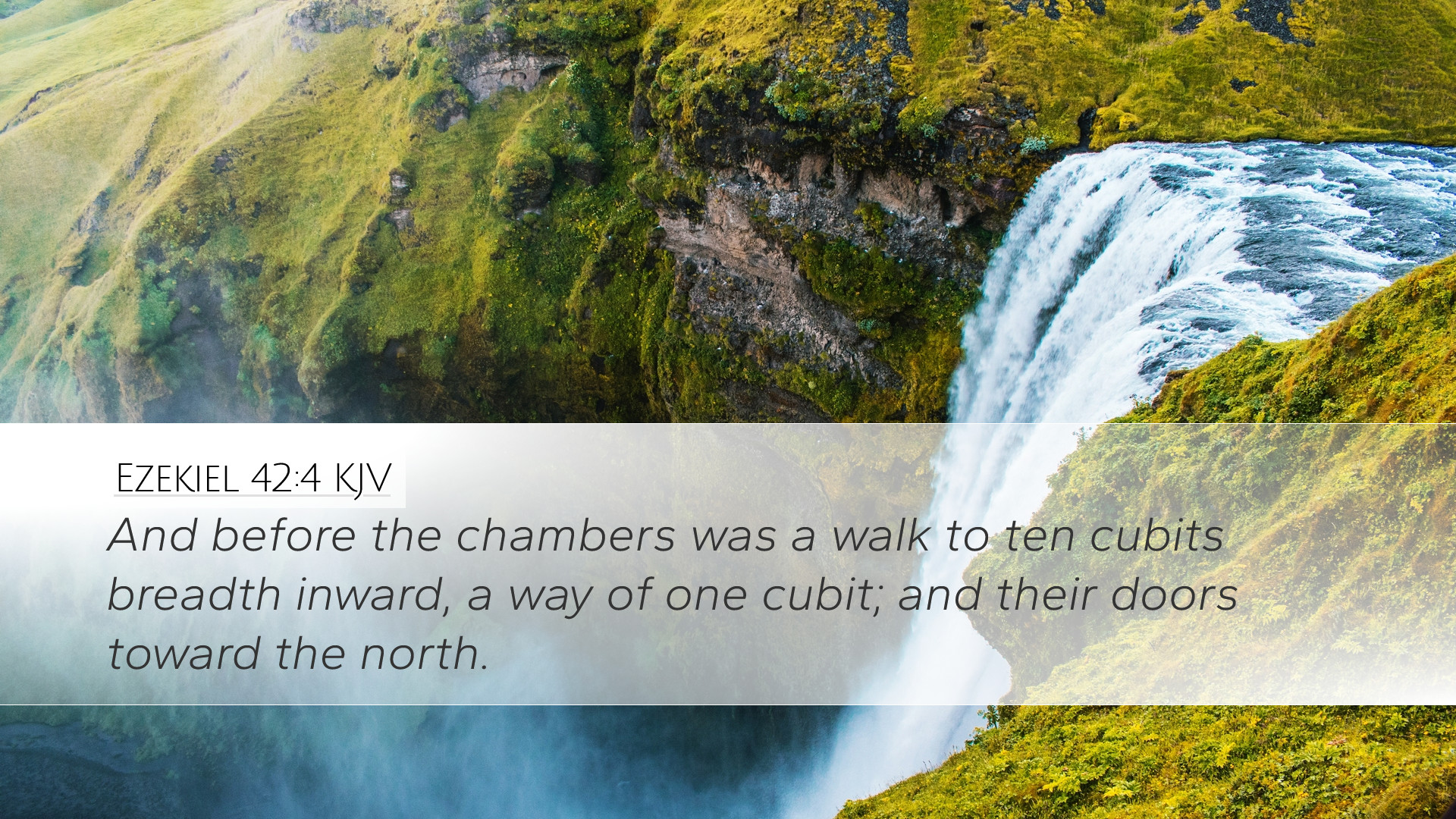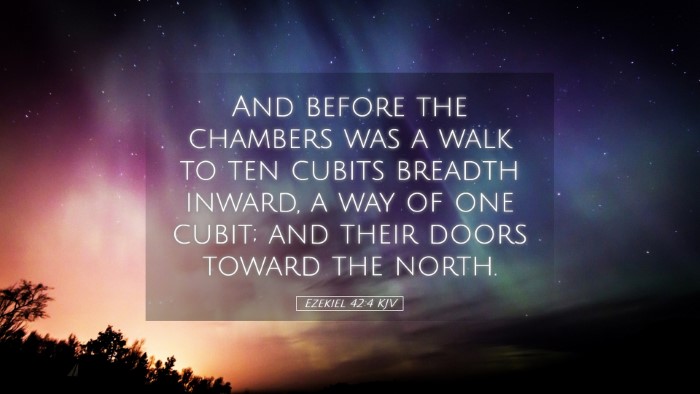Ezekiel 42:4 - Commentary Overview
Ezekiel 42:4 states, "And the width of the walk that was before the chambers was twenty cubits,
outward from the chambers, a way of ten cubits, and their doors toward the north." This verse takes place
within a detailed vision given to the prophet Ezekiel concerning the new temple and its layout. Various
public domain commentaries provide valuable insights into the significance of the dimensions and arrangements
presented by Ezekiel.
Contextual Significance
Ezekiel's visions, particularly in the latter chapters of the book, focus on the restoration of Israel
and the ideal worship structure that will culminate in God's presence among His people. The detailed
descriptions serve multiple purposes, including establishing a pattern for worship, symbolizing order and
holiness, and foreshadowing the ultimate restoration of both the physical and spiritual aspects of life in Israel.
Commentary Insights
Matthew Henry's Commentary
Matthew Henry discusses the specificity in the dimensions of the temple structure as indicative of God's
attention to detail and the importance of order in worship. He notes that the provision for adequate
spaces around the chambers emphasizes separation and sanctification, suggesting that the worship
community must prepare to enter into God's presence with reverence. The mention of the width of the walk
"twenty cubits" indicates a space large enough to facilitate movement, reflecting both accessibility and
a need for careful approach to the divine.
Albert Barnes' Notes
Albert Barnes focuses on the functional aspects of the dimensions provided. He interprets the
"way of ten cubits" as a necessary provision for effective movement and a connection to the sacred areas
of worship. Barnes emphasizes that every aspect of the temple measurements signifies a deeper spiritual
truth—the layout is intended for the spiritual health of Israel. The carefully designed paths provide
a means for the people to transition from worldly concerns into a divine atmosphere, symbolizing
repentance and spiritual readiness.
Adam Clarke's Commentary
Adam Clarke provides a critical analysis on the implications of these architectural features. He posits
that the "doors toward the north" could symbolize a direction that was not commonly associated with
divine encounters in the scriptures. This geographical consideration suggests a willingness to reach out
to places deemed less favorable or socially acceptable, perhaps indicating a message of inclusivity in
God’s redemptive plan. Clarke's attention to these details leads to an understanding that God desires to
meet His people in unexpected places, further expanding the vision of a redeemed community.
Theological Implications
The arrangement of the temple in Ezekiel 42:4 serves not only as a historical reference but also holds
theological implications. It signifies a restored relationship between God and His people, emphasizing the
necessity of properly ordered worship and community life. Each measurement and decision reflects God's
nature and character—detailed, intentional, and relational.
Worship and Accessibility
The arrangement described promotes accessibility to God's presence, which is a central theme throughout
the biblical narrative. It suggests that while God is indeed holy, He desires fellowship with humanity.
The structured approach to worship in Ezekiel emphasizes the need for a prepared heart as one approaches
the divine.
Symbolism in Dimensions
The dimensions specific to this walk convey a broader theological symbolism. Twenty cubits signifies
completeness and order, while the ten cubits highlights a direct path to God, symbolizing
the divine provision for worship. In biblical numerology, numbers often carry significant meanings; here,
they reflect the fullness of God’s design for His people.
Practical Applications
For modern pastors and theology students, the intricacies of Ezekiel 42:4 allow for rich practical
applications in church leadership and community worship space design. Understanding the principles behind
Ezekiel's vision encourages a return to intentionality in how churches are structured to facilitate
worship and community. This could include:
- Creating Accessibility: Ensuring worship spaces are accessible for all congregants.
- Designing for Reverence: Structuring service elements that guide congregants in approaching God.
- Prioritizing Community: Engaging in collective spiritual practices that prepare hearts for worship.
Conclusion
Ezekiel 42:4, while seemingly straightforward in its architectural details, opens a gateway to profound
theological insights regarding worship, community, and God’s reach into all facets of life. By examining
the commentaries of Matthew Henry, Albert Barnes, and Adam Clarke, modern readers can appreciate the
depth of God’s design as it reflects His character and intentions towards humanity. There is much to learn
about how God's instructions for the temple not only shaped ancient worship but continue to instruct and
inspire the church today in its mission to embody God's presence in the world.


